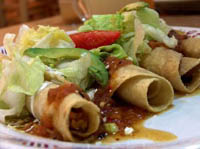Food is an essential aspect of Mexican culture and identity, as it plays a major role in everyday life, social occasions, business events and all celebrations. The cuisine in this country is a fusion of Mesoamerican cooking with Spanish elements.
Because of the variance in geography, climate and ethnicity, food in Mexico may vary from one region to another. For example, beef preparations are more likely to be served in the northern part of Mexico, while the southeastern part of the country is known for chicken-based dishes. Similarly, states along the Gulf of Mexico or the Pacific Ocean are famous for their fish preparations.Some of the basic staples of Mexican cooking include beans, chili peppers, avocados, meat (pork, beef, chicken and lamb), dairy products, herbs and spices. However, corn remains the most common staple in most Mexican dishes. It is the main ingredient in Tortilla, Mexican bread, which is eaten in various forms and at any time of the day.
Mexican food is easily available in the US and the UK and so residents from these countries are no strangers to this cuisine. Delicacies from this country that are recognized internationally include tacos (a crisp, folded tortilla with filling), guacamole (an avocado-based dip), burritos (a wrap filled with meat or beans), enchiladas (a stuffed tortilla in sauce) and quesadillas (a stuffed tortilla with cheese).
However, in other nations this cuisine has been adapted to suit local palettes. Therefore, an expat’s experience with authentic local food in Mexico may be relatively different. Regional dishes that are definitely worth a try include barbacoa (lamb cooked in an oven covered with maguey leaves), carnitas (deep fried pork), chicharron (crunchy deep fried pork skin), chilaquiles (tortilla chips with sauce and meat), cochinita pibil (slow-roasted pork), gorditas (stuffed corn patties), pozole (meat broth with corn, vegetables and spices), sopa de tortilla (tortilla soup), sopes (corn patty topped with sauce and meat), Tlayuda (crisp tortilla covered with beans, meat and vegetables) and tortas (lightly fried sandwich).
The people of Mexico eat well and quite often throughout the day; on average, a person has 4 to 5 meals on a daily basis.
Since Mexicans tend to rise early in the morning, they eat their first meal between 7:00AM and 9:00AM, before they leave for school or work. A typical Mexican breakfast, Desayuno, is a light meal that comprises of hot chocolate, coffee or atole (a hot thick drink made of corn, oats or rice), fruit and sweet bread.
Between 9:00AM and Noon, people have a heavy breakfast or brunch, known as Almuerzo. This is generally the heaviest meal of the day, comprising of eggs or a meat dish. Sometimes, people opt for fried tortillas in a sauce, like enchiladas or chilaquiles. In the city, breakfast business meetings are quite popular, especially in chain restaurants like Vips and Sanborns. Many people skip this meal for an early lunch.
Lunch or Comida is the main meal of the day, eaten anywhere between 2:00PM and 4:00PM. It often consists of 3 courses, which are soup (sopa), salad (ensalada), the main dish (guisado) and a dessert (postre). Working people often opt for a set meal or comida corrida. Several workers go home to have lunch with their families.
Mereinda, known as tea time or cocktail hour, is a pick-me-up early evening meal, generally consumed between 5:00PM and 7:00PM. In cafes, this normally comprises of cappuccino or tea with some kind of pastry. During this time, bars generally offer cocktails, with savory munchies. Botanas, antojitos and tentempies are a common part of Mereinda, which is less of a meal and more of a way to socialize, especially over the weekends.
Dinner or Cena is the last and generally the lightest meal of the day, normally consumed between 7:00PM and 9:00PM. Mexicans are known to dine at home, in cafés, restaurants, bars and even at a street stand.
While most of the food and beverage establishments in Mexico adhere to hygiene norms, this is not necessarily the case for street vendors. Therefore, it is best for expats to avoid eating food from street stands.
Drinks
Mexico is known for its production of tequila. Yet, the most commonly consumed alcoholic beverage is beer, and therefore a wide variety of imported and domestic beers are easily available across the country. Local wine is cheap and not the best in quality, which is why most expats opt for the more expensive imported wines.
When it comes to non-alcoholic beverages, soft drinks are available in a wide variety of international and local brands. Bottled and fresh fruit juices are also easily available at most places. Mexico is paradise for coffee and hot chocolate lovers too.

